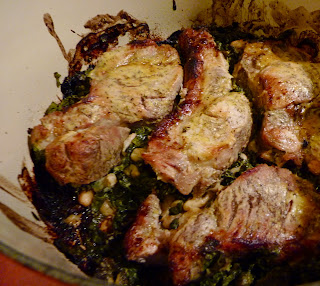How could I do this to you, dear reader?
On Chowhound when you fill out your profile, they ask what your "go-to dinner party dish" is. I only put down two things, a sublime tomato soup and roast pork with mustard, herbes de Provence and thyme.
This pork has saved me countless times with guests and family, but for me the clincher is that it is one of my personal favorites. Every time I take my first bite I am astonished by how extraordinary this dish is. This isn't fancy cooking, rather it is rustic French farm fare. For me that is some of the best the culinary world has to offer.
I found this recipe for Roti de Porc au Thym (Roast Pork with Thyme) in the September/October 2001 issue of Saveur magazine. That particular magazine is covered in grease because I have put it to such good use. Inside you'll also find a terrific French lentil salad and my favorite recipe for Arroz con Pollo.
This is a recipe for those of you who don't have a lot of time for chopping and mixing and measuring, but are still foodies at heart and want the end result to be divine. If you can handle browning the roast, the rest of the process is a breeze.

The recipe calls for a boned pork rib roast, but allows for substituting the loin end, shoulder, or blade end. What I typically purchase at the market is the large pork loin roast (not the tenderloin!), because that is what I routinely find. Shoulder would be great too, if a little fattier. However the loin works well, and because of its even shape you don't need to tie it up.
The marriage of pork drippings, mustard, thyme and herbes de Provence leaves no room for wanting garlic or onions. The flavor is just right. I don't really use herbes de Provence for anything else, though I'd be willing. The hint of lavender seems exotic, as if you're walking through fields of purple flowers in France.
Ironically, according to Wikipedia, lavender is only added to the American blends of herbes de Provence. Is this true? The typical mix includes savory, fennel, basil and thyme. The mix I've used lately from Penzeys includes rosemary, fennel, thyme, savory, basil, tarragon, dill weed, oregano, lavender, chervil and marjoram. This might be overkill (although it's quite good), but I certainly wouldn't want to give up the lavender, no matter how much it screams American.

After browning the meat on all sides, dijon mustard is slathered over the top of the roast. The herbes de Provence are scattered over and thyme branches are placed on top. One cup of water is poured into the bottom of the pot. The pork in a heavy bottomed pot -- preferably of the Le Creuset ilk -- is covered and nudged into a 425 degree oven, where it cooks for just 45 minutes. Basting every 15 minutes is essential.

Your pork needs just a wee rest on the counter, maybe fifteen minutes, and then it is ready to carve. Right? It doesn't get much easier than that!

The pork is remarkably succulent. Carving the meat always produces a puddle of precious juices that must be guided with care back into the pot with the rest of the pan drippings. The resulting sauce is superb.

The perfect accompaniment that properly showcases the sauce is a tiny pasta. Orzo is my preference because I like how slippery it is and how that feels in my mouth, but fregola sarda or any of the other little babies will work well too.
I don't want to oversell this recipe, because I wouldn't want to disappoint you, but I'm using words like superb and divine with complete sincerity. I really think you'll love this dish.
Roast Pork with Mustard, Herbes de Provence & Thyme
Adapted from Saveur Sept./Oct. 2001 Roti de Porc au Thym
1 4 lb. pork rib roast, boned
Salt and freshly ground black pepper
1 tablespoon butter
1 tablespoon peanut or other neutral vegetable oil
1/2 cup dijon mustard
1 tablespoon herbes de Provence
6 branches fresh thyme
Preheat oven to 425 degrees. Place rack in the middle of the oven.
Generously salt and pepper the pork all over. Melt the butter and oil in a large Dutch oven with a lid that fits snugly. Brown meat thoroughly on all sides, about 5 minutes or so per side.
Turn the pork fatty side up, and spread with the mustard, evenly over the top. Crush the herbes de Provence with your fingers and scatter them over the meat. Rest the thyme branches on top of the pork. Add 1 cup water to the bottom of the pot and cover.
Put the pot in the oven and roast the pork, basting every 15 minutes, until the temperature reaches 135 degrees. This should take about 45 minutes. Remove the pot from the oven and set the lid ajar. Let the meat rest for 15-20 minutes. Discard the thyme branches, and place the meat on a carving board. Thinly slice the meat and serve with the pan juices spooned over.
Serves 6-8


























